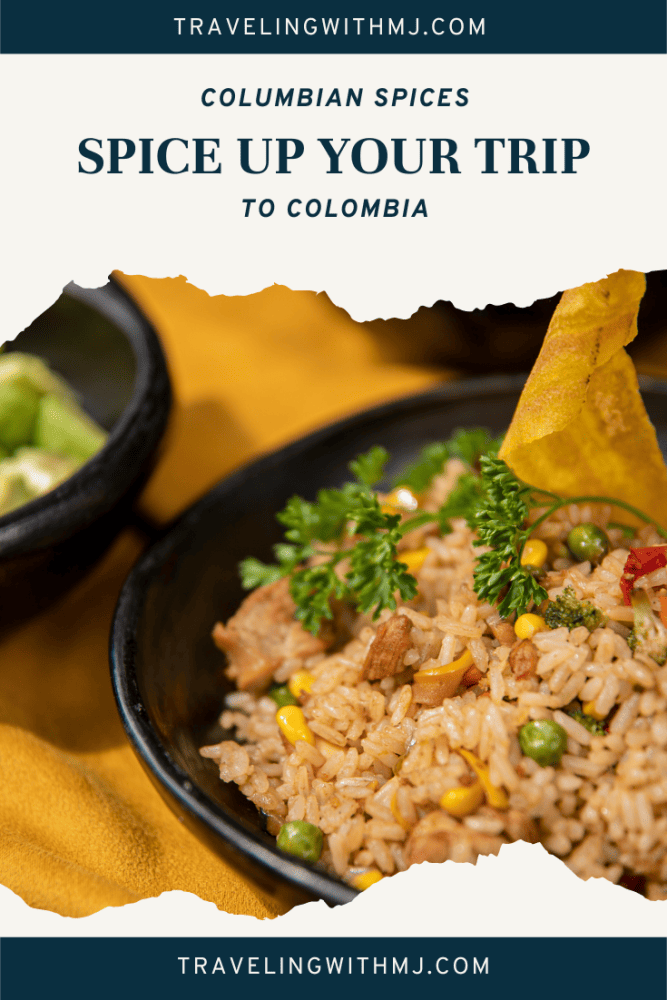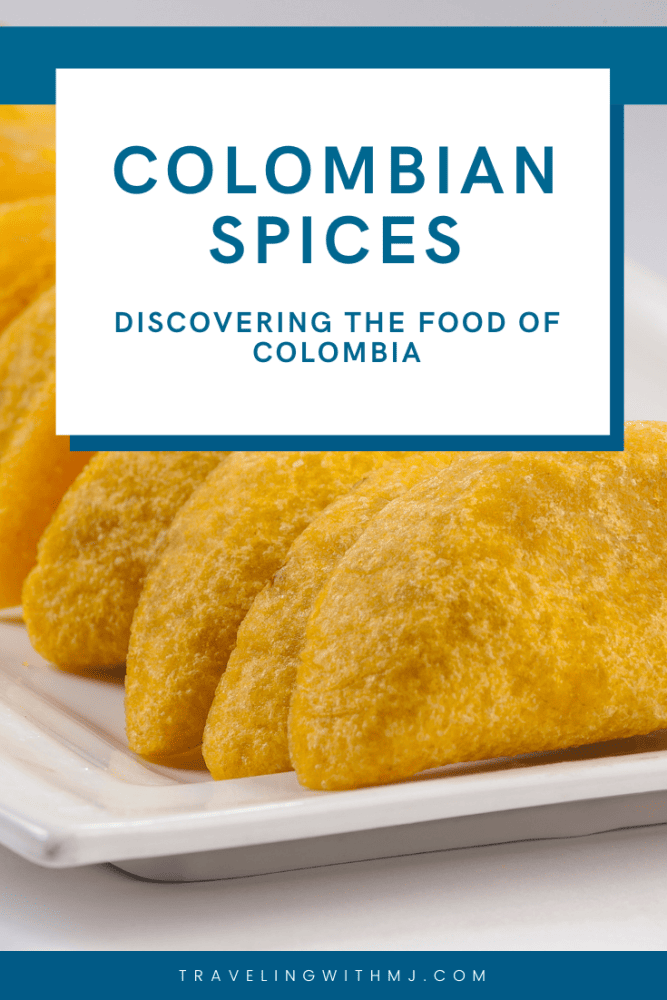I love exploring the culinary side of destinations that I visit. From restaurants to food tours, cooking classes to markets, I love getting a literal taste of the destinations where I travel.
What’s better than discovering great food when you travel? Finding ways to re-create that food at home.
After a trip to Bogota, Colombia, I was determined to learn how to enjoy some of my favorite dishes at home. I quickly learned that it was all about the spices and seasonings, not all of which are readily available where I live. I’ve learned to adapt and overcome.
This post will guide you through the essential spices that define Colombian cuisine, bringing the charm of Colombian kitchens to your own. Grab an apron and get ready to add a dash of Colombian flair to your home-cooked creations.
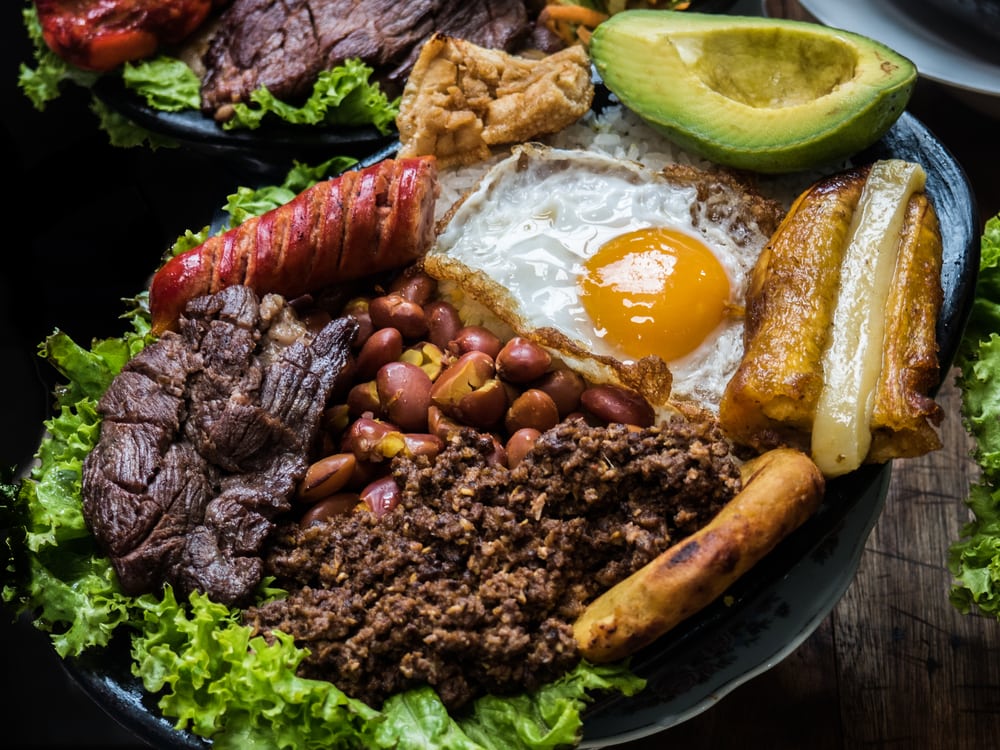
Colombian Cuisine Basics
Colombian cuisine is reflective of regional influences, with a blend of spices and seasonings that elevate the simple to impressive. Like other countries in Latin America, Colombia’s culinary contributions evolved from a blending of foods native to the land, the traditions of the Spanish settlers, and the immigrant populations. Potatoes, corn, beans, cassava, rice, and tomatoes are some of the staple crops, with all but rice being native to Colombia.
Spanish conquerors brought chicken, pork, and beef with them, and those meats dominate Colombian restaurant menus and at home. Since Colombia also has a Caribbean coastline, seafood is popular as well.
There are lots of exotic fruits (to me, at least) available in Colombia. This includes tamarillos, strawberry guavas, pineapple guavas (also known as feijoas), cherimoyas, starfruit, mamey, and ice cream bean. Most of these fruits are delicious eaten fresh, as I discovered on a market tour, each vendor offering up a little taste. Fruit is also used for fillings in pastries, and for drinks we thinks of as a smoothie or milkshake.
Traditional Cuisine of Colombia
From an explosion of flavors to a bowl of comforting warmth, Colombia’s traditional cuisine will tantalize your tastebuds. I ate at street food stalls serving traditional dishes like arepas and empanadas, as well as fine dining restaurants featuring modern takes on Colombian cuisine, and found lots of options that suited my palate preferences and my budget.
Here are a few of the popular dishes I enjoyed in Colombia.
Ajiaco
One of the dishes I fell in love with when I visited Bogota was ajiaco. I liked it so much that I took a cooking class to learn how to make ajiaco and later did a market shopping tour to learn more about the ingredients.
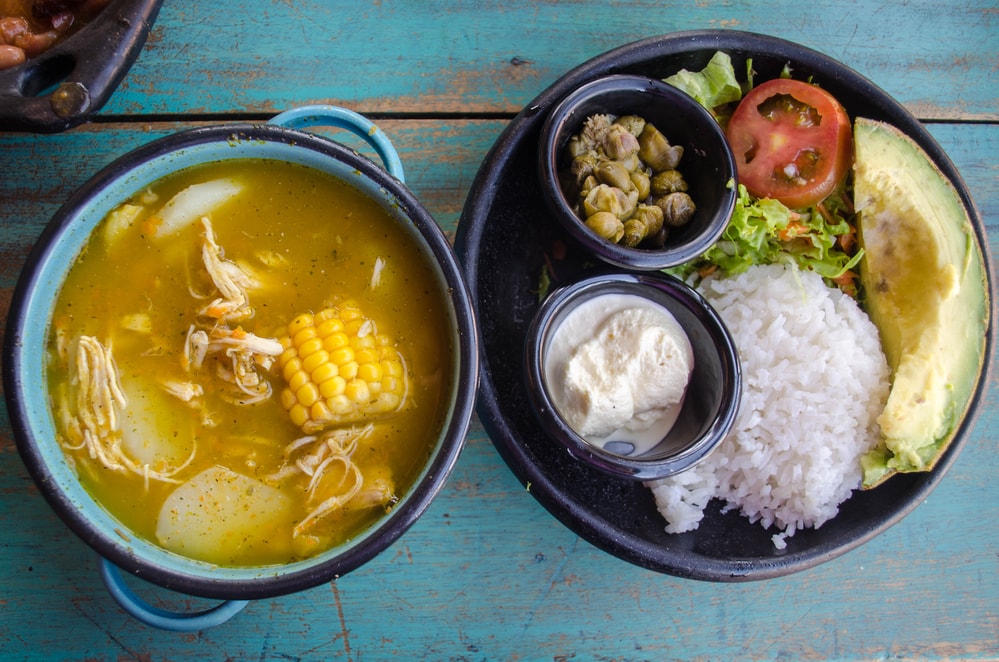
Ajiaco is a traditional Colombian soup made with chicken, potatoes, and corn. It is flavored with a variety of herbs and spices, including cilantro, capers, and guascas, and is usually served with a dollop of sour cream and rice. The dish is a staple of Colombian cuisine, culture, and national identity, and is a popular comfort food for locals as well as visitors.
This is not your typical chicken soup or potato soup! This is Colombian chicken stew and is fun to make. The stew contains corn, several kinds of potatoes, and a special Colombian herb called guascas that has a distinctive taste that some people have characterized as an artichoke-type flavor. Ajiaco It is often eaten with capers and sour cream as garnishes. I would have happily enjoyed this for most every meal that I ate in Bogota!
It’s fairly easy to make, although some of the ingredients require substitutions here at home. Check out this recipe for Ajiaco.
Arroz con Coco
Coconut Rice is basically rice cooked in coconut milk instead of water. As the coconut milk boils down, the remaining oil and bits of solids become toasted and crunchy. This creates a dish that has a rich, nutty flavor., with small bits of sweet toasted coconut for crunch.
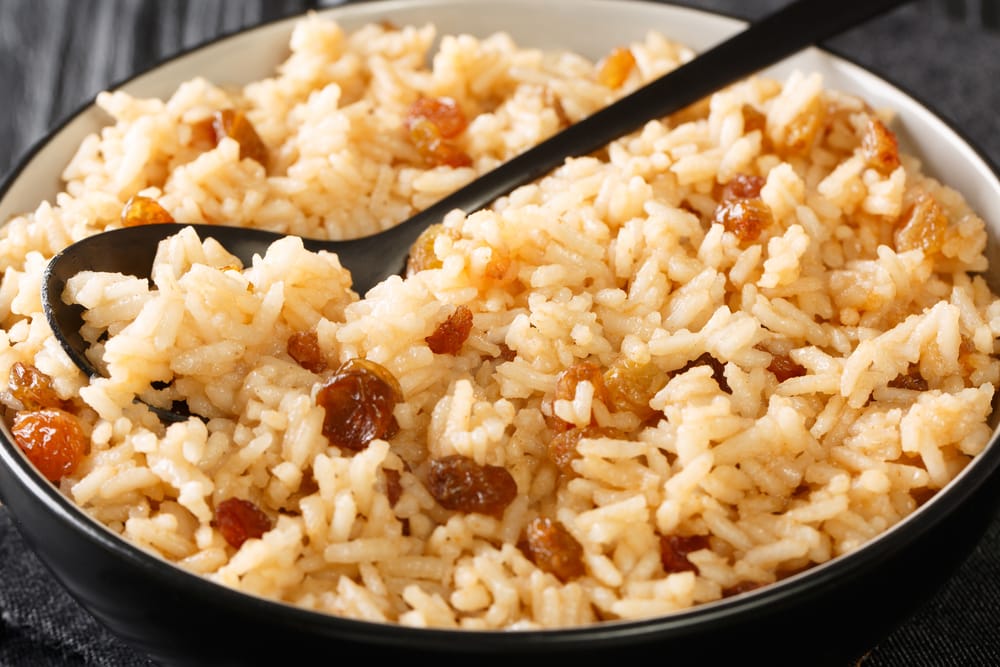
I first tasted arroz con coco in Cartagena, mistakenly calling it a rice pilaf dish. It is that, but also much more. It’s popular along much of the Caribbean coast and, depending on spices and seasonings added, can be a sweet or savory dish.
The traditional version of arroz con coco has a little sugar (I prefer brown sugar) and raisings added. It’s perfect as a side dish to grilled meats. I love it with grilled shrimp. It also works well with fish, or even with enchiladas.
I also found savory versions of arroz con coco, with recipe ingredients like like turmeric and curry. This version was creamier, more like a risotto, and served in much the same way. It was tasty, but I’ll take the traditional any day.
Arepas
Arepas are most easily described as a griddle cake. That’s oversimplifying it, though, as they can be thin and crispy like a tortilla, or thick and fluffy like a pancake. With a slightly sweet corn flavor, arepas become a base for a variety of flavors and dishes. I think f them as the little black dress of Colombia food – they can be dressed up or down – and be adjusted to meet your favorite flavor profile and taste buds.

I saw arepas on menus for every meal of the day. For breakfast, they were paired with a fried egg, fruit, and coffee. For lunch and dinner, they were served with soups and stews, and were dunked into broth. And for a snack as street food, they were split open and stuffed with meats, vegetables, cheese, and beans.
Empanadas
Many people are familiar with empanadas, and these fried turnovers have roots in many different countries and cultures. Traditionally, empanadas are a snack or appetizer, but you will occasionally see them as part of a larger meal.
In Bogota, I found street vendor carts selling empanadas on nearly every street corner in the historic section of the city. There were also lot of restaurants serving them to-go, and patrons would buy a bag full of them.
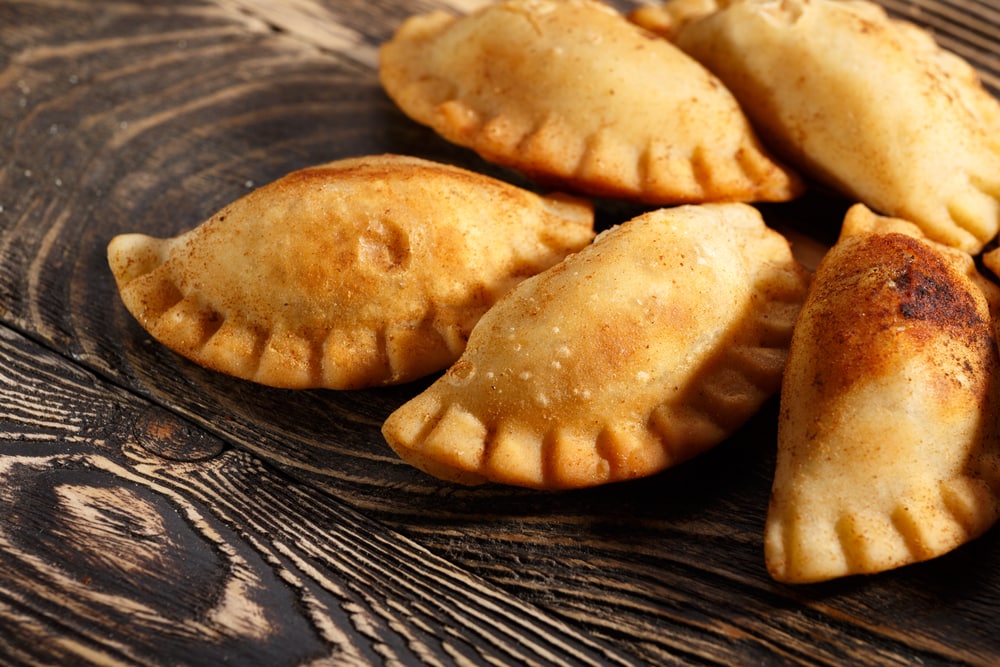
With fillings full of rich flavors and unique spices tucked into a cornmeal dough, they were about the size of my palm (about one or two bites). The crisp and crumbly crust contained ingredients like beef, potatoes, peas, onions, and cheese.
Tip: Try empanadas with aji sauce, It’s a spicy green sauce made with cilantro, jalapenos, and mayonnaise, and is a nice complement to the empanada.
Pan de Bono
“Pan” means bread in Spanish and refers to this distinctly Colombian bread, which is made from cassava flour, corn flour, egg, and lot of cheese.
It’s cheesy bread! Small and around, about the size of a golf ball, it has a crisp, golden crust and a light, airy interior. The salty cheese melts throughout the bread creating pockets of gooey goodness.
Pan de bono is usually served for breakfast or as a morning snack, accompanied by a robust cup of Colombian coffee or hot chocolate. It is also served as part of an snack platter with other snacks like arepas and empanadas. It can be found on many menus, and also at bakeries.
Colombian Spices
What about the spices that are used in Colombian cuisine?
Spices are prominent, and most dishes have a bit of heat, but traditional Colombian food isn’t generally spicy compared to food from other parts of Latin America. Hot chilis and hot peppers are not a staple ingredient in most Colombian dishes. Colombian cuisine focuses more on on complex flavors achieved through herbs, vegetables, and cooking techniques, along with umami-rich ingredients like plantains, beans, and corn. Some regions, like the Caribbean coast, incorporate aji peppers for a bit of heat, but it’s usually subdued and balanced with other flavors, rather than knock-your-socks off fire in your mouth.
Some of the spices found in Colombian dishes (and that you can pick up to recreate your favorites at home:
Cracked Black Pepper
European colonists brought black pepper to South America, where it was quickly incorporated into local cuisine. It’s unusual to find a Colombia dish that does not call for ground black pepper.
Instead of using it for heat, though, Colombian dishes use black pepper to balance out flavors and round out a blend of other spices. It also helps to bring out the natural sweetness of vegetable staples like corn and plantains.
Cumin
Cumin is a warm, earthy spice that was introduced to South America by Spanish and Portuguese colonists. Cumin can be used as a stand alone spice, or in combination with onion and garlic. That combination forms a base for many stews, sauces, and other savory dishes. It’s also used in hagao, a Colombian variation of sofrito.
Cumin can be used whole or ground, and can be added to dishes at any point in the cooking process. Whole cumin seeds can be toasted before use to enhance their flavor. Ground cumin is a common ingredient in spice blends, sauces, and marinades.
Allspice
Allspice is native to South America and has been used in Colombian cooking since before colonization. The dominant flavor is clove, with hints of cinnamon and nutmeg, with a slightly sweet undertone. It is frequently used in desserts, but in Colombia, it is also used in savory dishes as well.
Menu items like stewed meats, rice dishes, empanadas, and stews all likely incorporate cumin into their recipes.
Cinnamon
Cinnamon is another spice that European settlers brought to Colombia. Sweet and aromatic, and used in ground or stick form, cinnamon plays a starring role in Colombian cuisine.
Natilla (custard) and bunuelos (fritters) are popular cinnamony desserts. They made frequent appearances on restaurant menus. It’s also used in spiced drinks and cocktails made with rum or aguardiente, a distilled spirit with a slight anise flavor. Aguardiente doesn’t have the strong licorice flavor of ouzo or sambuca, but it packs an equally powerful punch.
But cinnamon isn’t just for sweet treats! It’s also added to savory dishes to bring out more complex flavors.
Sazon
While Sazón is a popular seasoning blend widely used in Latin American cuisine, including Colombian dishes, While not native to Colombian cuisine, it’s a very popular spice mix that combines garlic powder, onion powder, coriander, cumin, achiote, and salt. The brand I saw commonly in Bogota is from Goya Foods; I found that same brand at home. It comes in a shaker bottle, or individual packets (like taco seasoning). It’s a staple in most homes as it is an easy shortcut to personally blending multiple spices.
Sazon is used in soups and stews, rice dishes, and grilled meats. I have a carne asada recipe that calls for it, and looking forward to giving it a try.
Achiote
Achiote, also known as annatto, is a natural orangey condiment used in Colombian cuisine. Achiote has been used for thousands of years by indigenous peoples of Central and South America as a dye for fabrics, body paint, and as well as a spice in cooking.
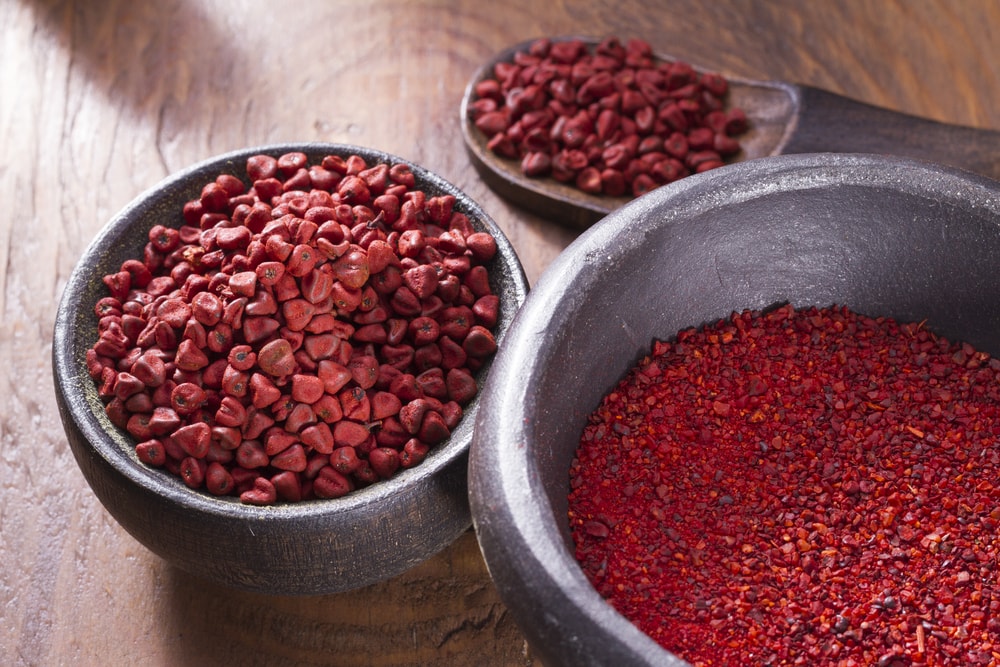
It comes in various forms. Achiote seeds are small, triangular, and hard, and are typically soaked in oil to release a vibrant color and flavor. The achiote oil can then be used as a drizzle of flavoring, in a marinate for grilled meat, or in a sauce or sofrito. I think of it as a flavorful substitution for olive oil. It is also available commercially as achiote paste, for us home cooks who don’t have the time to make our own. It still provides solid flavor and color. Achiote powder is also available, but it primarily provides color and lacks the depth of flavor found in seeds or paste
Chilis
Colombian cuisine isn’t generally characterized by intense spiciness like other Latin American countries. While chilis do play a role in some dishes, they’re used more for aroma and subtle flavor variation than fiery heat.
Chilis you are likely to see include aji (small bell peppers used in a delicious sauce to accompany empanadas), and tabasco and cayenne. Tabasco and cayenne chilis are mostly for export, not typically for local consumption.
Guascas
Guascas herb, also known as Galinsoga parviflora, is a plant native to South America, particularly the Andean region, including Colombia, Ecuador, and Peru. It is a member of the aster family and is commonly used in traditional Colombian cuisine, particularly in the popular soup, ajiaco.
It has a distinctive flavor and aroma, which is described as slightly bitter and earthy. I think guascas tastes a lot like cilantro (fresh, but a little soapy), but others in my cooking class thought is had a bitter licorice taste.
The fresh herb is difficult to find outside of South America, but if you have a good Latin America specialty store near you, you may luck out. I found it in dried form online. Dried will never be as good as fresh, but it’s a reasonable substitute here in the United States.
For Pinterest
Save to your favorite travel and food Pinterest boards
